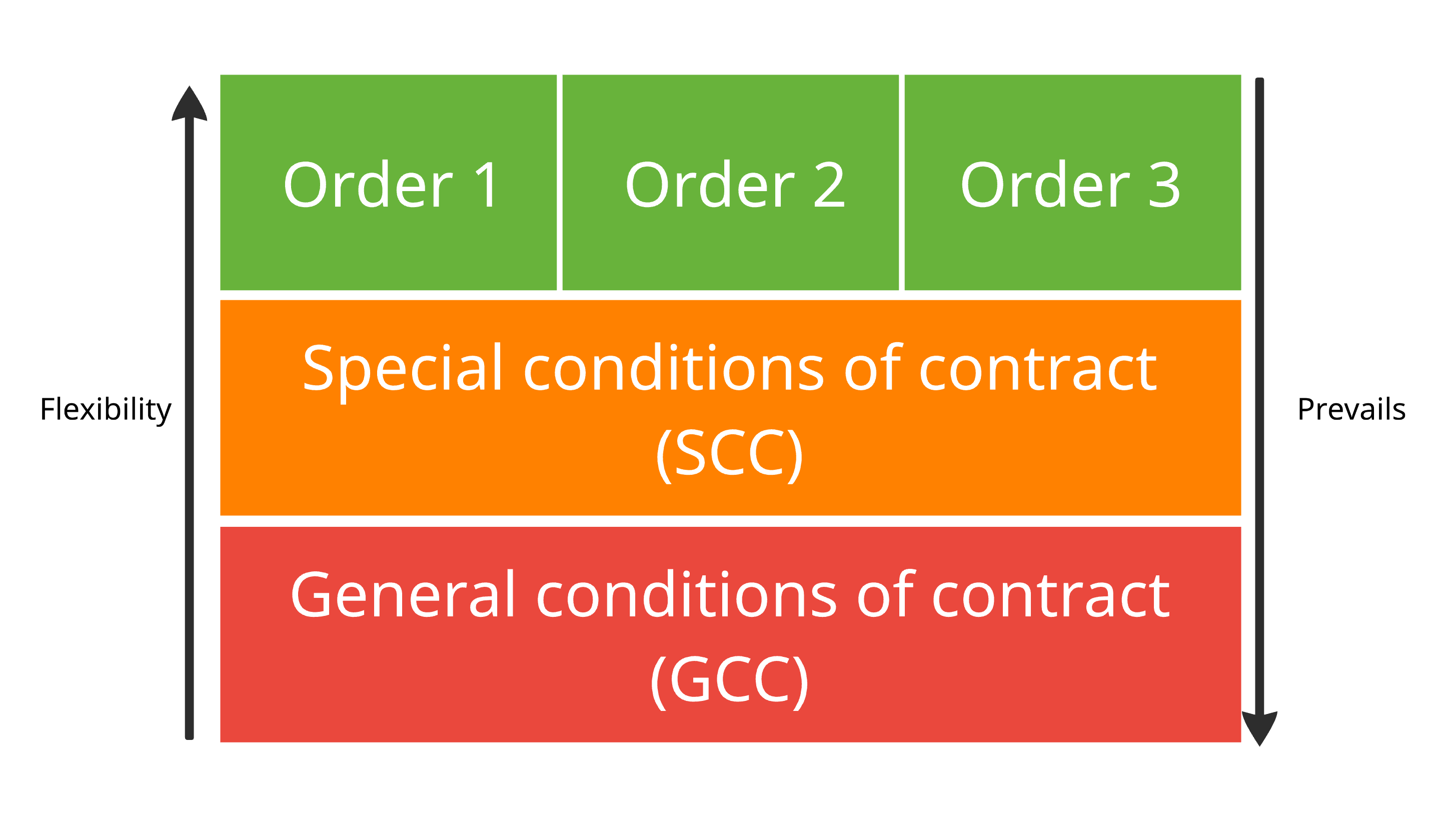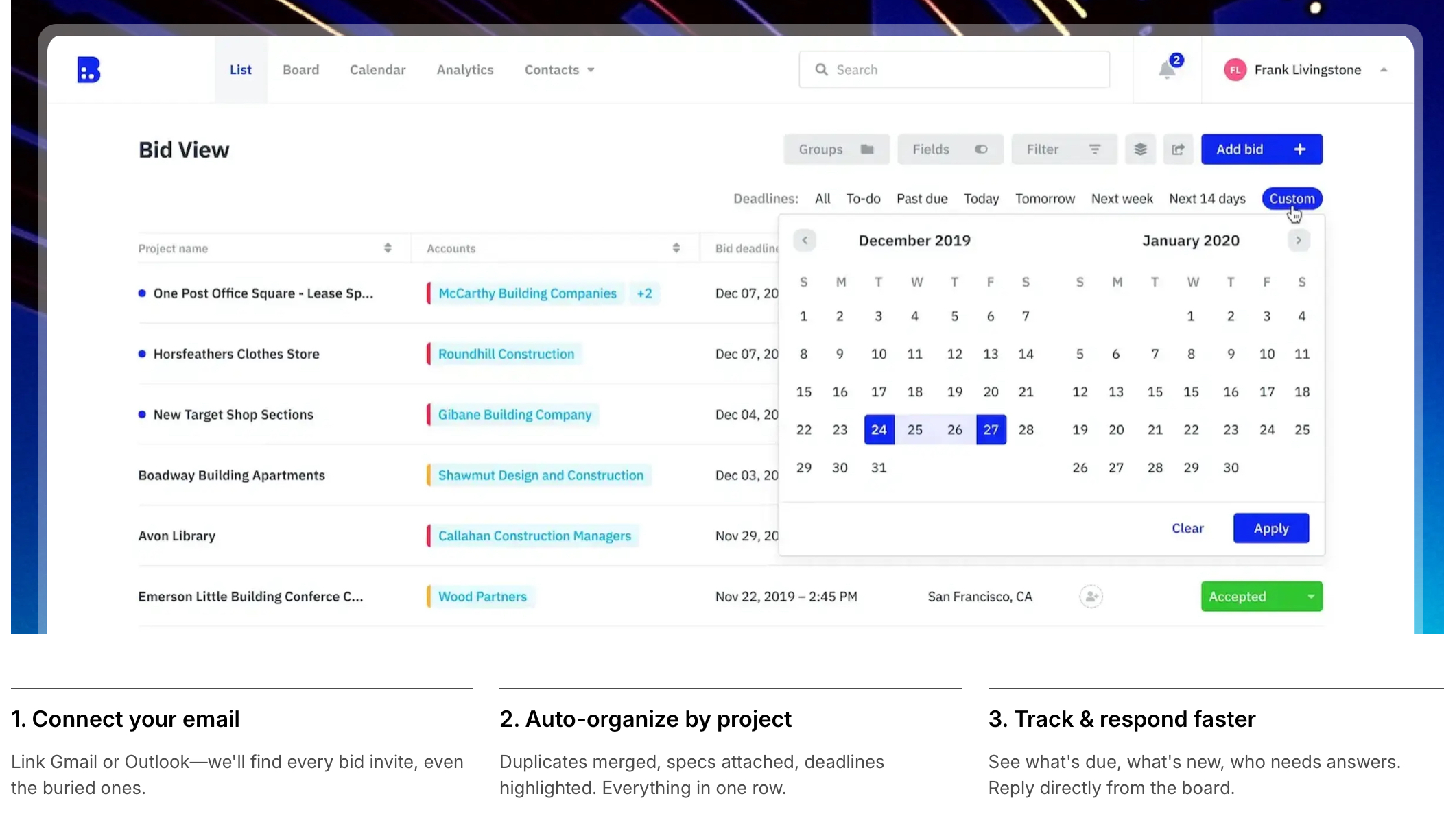You've likely encountered those dense general conditions documents while reviewing project specs on bid boards, wondering which clauses actually matter for your bid. You need to thoroughly review these foundational contract elements as they can affect success of your construction project.
Most contractors struggle to work through complexities without missing important requirements that come back to haunt them later. Today, we'll understand general contract conditions, along with examples, costs and best practices.
TLDR:
- General conditions create legal frameworks and cost 6-12% of project value for indirect expenses
- AIA A201 serves as the industry standard, defining contractor-owner-architect relationships
- General conditions are the contract clauses setting legal framework, while general requirements detail project-specific administrative and temporary work requirements
- Proper documentation of general conditions can help maintain consistency and reduce risk overlooking critical requirements
- Accurate estimation requires historical data and understanding of project duration impacts

What Are General Conditions of Contract
General conditions of contract form the backbone of every construction project, setting up the fundamental rules that govern how owners, contractors, and architects work together. Think of them as the constitutional framework that defines everyone's rights, responsibilities, and procedures throughout the project lifecycle.
These conditions appear in three distinct contexts that often confuse contractors. But you can simply understand that they:
- Exist as actual contract clauses that spell out legal relationships and obligations
- Appear in project specifications as administrative requirements
- Represent a cost category for indirect project expenses like supervision, temporary facilities, and project management
Understanding general conditions helps in creating a roadmap for successful project delivery that protects all parties involved.
For contractors working in today's competitive market, mastering these conditions can mean the difference between profitable projects and costly disputes.
Key Components of General Contract Conditions
Every general set of conditions covers several critical areas that form the foundation of successful project execution. These components work together to create a complete framework for project management and risk allocation.
Project administration requirements include provisions for project meetings, submittal procedures, progress reporting, and communication protocols. These details become important when disputes arise or when coordination breaks down between multiple parties.
Payment terms and procedures covers everything from application processes to retention policies. Clear payment provisions help maintain cash flow and reduce disputes that can derail project schedules.
Change order procedures deserve special attention since virtually every construction project experiences modifications. Well-defined change processes protect both owners and contractors by creating clear approval chains and documentation requirements.
Insurance and bonding requirements protect all parties from different risks inherent in construction work. These provisions specify coverage amounts, and claims procedures that can impact project costs. Safety protocols and regulatory compliance reference specific safety programs and regulatory frameworks that contractors must follow.
Modern bid board systems like Downtobid help contractors centralize bid documents and specs, making it easier to review general conditions alongside other requirements. By centralizing all project documentation and requirements, contractors can make sure they're covering every component of the general conditions in their proposals.

AIA A201 General Conditions Standard
The American Institute of Architects' A201 General Conditions document serves as the gold standard for construction contracts across the United States. This document has evolved over decades to handle the complex relationships between owners, contractors, and architects in construction projects.
A201 sets up the contractor as the primary party responsible for construction means and methods while positioning the architect as the owner's representative for design and quality control. The document covers important areas, including:
- Contract administration
- Subcontractor relationships
- Changes to the work
- Time extensions
- Payments
- Dispute resolution
Each section builds upon the others to create a complete framework for project delivery. Recent updates to A201 have tackled new issues like electronic communications, sustainable construction practices, and enhanced safety requirements.
One of A201's greatest strengths lies in its widespread acceptance and legal precedent. Courts across the country have interpreted its provisions countless times, creating a body of case law that provides predictability for all parties.
Difference Between General Conditions and General Requirements
General conditions refer to the contract clauses that set up legal relationships, define responsibilities, and set procedures for project administration. These are the "rules of the game" that govern how parties interact throughout the project.
General requirements, on the other hand, appear in Division 01 of the project specifications and cover project-specific administrative and procedural requirements. These might include temporary facilities, project meetings, submittal procedures, and closeout requirements specific to that particular project.
Contractors in markets like Los Angeles and Dallas must carefully review both documents to guarantee complete bid coverage. Missing either component can result in major cost overruns or disputes during construction.
The confusion often arises because both documents cover similar topics but from different perspectives. General conditions might state that the contractor is responsible for temporary facilities, while general requirements specify exactly what temporary facilities are required for that specific project.
General Conditions Cost Estimation and Percentages
Accurately estimating general conditions costs requires understanding both industry benchmarks and project-specific factors. Industry data suggests these costs typically range from 6% to 12% of total project value, but this range can vary dramatically based on specific circumstances.
- Project duration: Longer projects require extended supervision, temporary facilities, and utilities, driving up the percentage of total costs. Conversely, fast-track projects might have higher monthly rates but lower overall percentages.
- Project complexity and location: Urban projects often require higher security, more complex logistics, and additional coordination, increasing general conditions percentages. Remote locations might require temporary housing, extended mobilization, and higher supervision costs.
- Size and scale of the project: Large projects can spread fixed costs like mobilization and temporary facilities over more work, reducing the percentage. Small projects might see general conditions approach or exceed 15% of total costs.
Market conditions in different regions can lead to different percentages.
Common General Conditions Examples
Understanding general conditions becomes clearer when looking at specific examples. These real-world applications will help you understand how contract provisions translate into practical construction projects.
- Project management costs include the project manager's salary, benefits, and expenses for the duration of the project. This might also include assistant project managers, schedulers, and administrative support staff dedicated to the project.
- Temporary facilities encompass job site trailers, temporary utilities, internet and phone service, and temporary roads or parking areas.
- Site security measures might include fencing, lighting, security systems, and guard services.
- Cleanup and waste management represent ongoing costs throughout the project, including dumpsters, waste disposal fees, final cleaning, and environmental compliance measures.
- Permits and inspections include building permits, specialty permits, and the administrative costs associated with obtaining and maintaining regulatory approvals throughout the project.
- nsurance costs include general liability, workers' compensation, builders' risk, and any specialty coverage required by the contract.
The scope of these varies dramatically based on project size, duration, and location requirements.
General Conditions Templates and Documentation
Proper documentation and standardization of general conditions help maintain consistency and reduce the risk of overlooking critical requirements.
Standard templates like AIA A201 provide thorough coverage of typical construction scenarios, but most projects require supplementary conditions that modify or add to the standard provisions. These modifications handle project-specific requirements, local regulations, or owner preferences that aren't covered in the standard template.
Customization should handle local building codes, environmental regulations, prevailing wage requirements, and other jurisdiction-specific requirements. What works in one market might not comply with regulations in another, making local expertise important.
For example, California public works projects require compliance with state-specific prevailing wage laws and may include additional safety and reporting provisions in the supplementary conditions.
Version control is important when multiple parties are working with contract documents. Clear procedures for document distribution, revision tracking, and approval processes help prevent disputes arising from outdated or conflicting information.
Understand which provisions can remain standard and which will require project-specific modification by carefully analyzing each project's unique requirements.
Best Practices for Managing General Conditions
Effective management of general conditions throughout the project lifecycle and to make sure that general conditions serve their intended purpose, follow these practices:
- Analysis and Optimization: Accurate estimation begins with detailed analysis of project requirements, historical cost data, and market conditions. Contractors should maintain databases of general conditions costs from completed projects to improve future estimates.
- Change order management: General conditions costs often extend when projects experience delays or scope changes. Clear procedures for adjusting general conditions costs make sure fair compensation for extended performance periods.
- Documentation requirements: Include photographic records, daily reports, and correspondence files that support general conditions costs and show compliance with contract requirements.
- Performance monitoring: Regular comparison of actual costs to budgeted amounts, identification of cost trends, and proactive management of cost overruns.
- Risk management: Identify potential issues that could impact general conditions costs and develop contingency plans to handle these risks. This might include weather delays, permit issues, or coordination problems with other contractors.
Modern technology tools can greatly improve general conditions management through automated reporting, digital documentation, and real-time cost tracking. Customer stories from Downtobid show how contractors have improved their bidding success and project management through better organization and documentation.
How Downtobid Helps You Master General Conditions

At Downtobid, we’ve seen how difficult it can be for subcontractors and suppliers to stay on top of general conditions across dozens of projects. Missed deadlines, buried RFIs, and overlooked requirements often lead to unnecessary risk and lost opportunities. We built Downtobid to automate the entire bid-tracking process and give you one clear view of everything you need to win more work.
With Downtobid, you can:
- Centralize all bid invites: We automatically pull every ITB from your Gmail or Outlook inbox, even ones buried in spam, and group them by project with specs, plans, and due dates attached.
- Stay ahead of deadlines: Our system highlights upcoming due dates, syncs them to your calendar, and sends reminders so nothing slips through the cracks.
- Keep your team aligned: Assign estimators, track progress, and make sure everyone knows who’s working on what, no more duplicate bids or missed coverage.
- Get clarity faster with AI: We automatically extract key project details, scope, timeline, location, so you can decide which bids to pursue without hours of manual review.
- Measure and improve: Built-in analytics show you win rates by GC, average turnaround time, and which trade scopes are the most profitable, helping you refine your strategy.
Downtobid is the modern alternative to legacy platforms like BuildingConnected, iSqFt, and PlanHub. Instead of juggling emails, spreadsheets, and multiple tools, you get a single, organized bid board that helps you submit more complete bids on time and improve your overall hit rate.

FAQ
What percentage of total project cost should I budget for general conditions?
General conditions typically range from 6% to 12% of total project value, but this varies greatly based on project duration, complexity, and location.
What's the main difference between general conditions and general requirements?
General conditions are contract clauses that create legal relationships and define responsibilities between parties, while general requirements appear in Division 01 specifications and cover project-specific administrative tasks. General conditions create the legal framework, while general requirements detail the actual work tasks.
How do I customize standard templates like AIA A201 for my specific project?
Start with the standard template but add supplementary conditions that cover local building codes, environmental regulations, prevailing wage requirements, and project-specific owner requirements. Focus on jurisdiction-specific regulations and unique project characteristics that aren't covered in the standard provisions.
When should I adjust my general conditions costs during a project?
Adjust general conditions costs whenever project duration changes due to delays, scope modifications, or change orders. Since many general conditions expenses are time-related (supervision, utilities), extended project schedules typically require proportional increases in these cost categories.
Final thoughts on mastering general contract conditions
General conditions might seem overwhelming at first, but they're your roadmap to smoother projects and fewer surprises. Build a systematic approach to reviewing these documents and tracking your actual costs against estimates.
Using a well-organized bid board helps you spot critical requirements before they become costly oversights. Start with the basics, build your knowledge through each project, and you'll find these complex documents becoming valuable tools for your success.